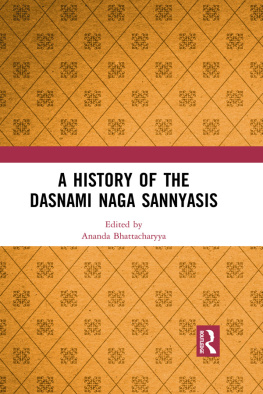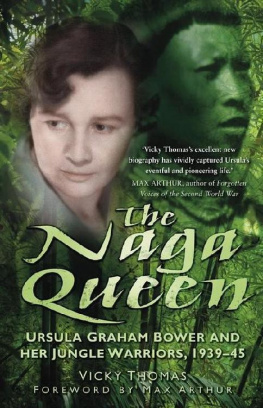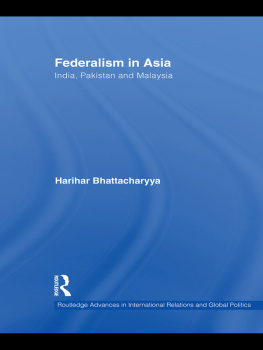Bhattacharyya Ananda - A History of the Dasnami Naga Sannyasis
Here you can read online Bhattacharyya Ananda - A History of the Dasnami Naga Sannyasis full text of the book (entire story) in english for free. Download pdf and epub, get meaning, cover and reviews about this ebook. publisher: Routledge, genre: Religion. Description of the work, (preface) as well as reviews are available. Best literature library LitArk.com created for fans of good reading and offers a wide selection of genres:
Romance novel
Science fiction
Adventure
Detective
Science
History
Home and family
Prose
Art
Politics
Computer
Non-fiction
Religion
Business
Children
Humor
Choose a favorite category and find really read worthwhile books. Enjoy immersion in the world of imagination, feel the emotions of the characters or learn something new for yourself, make an fascinating discovery.
- Book:A History of the Dasnami Naga Sannyasis
- Author:
- Publisher:Routledge
- Genre:
- Rating:5 / 5
- Favourites:Add to favourites
- Your mark:
- 100
- 1
- 2
- 3
- 4
- 5
A History of the Dasnami Naga Sannyasis: summary, description and annotation
We offer to read an annotation, description, summary or preface (depends on what the author of the book "A History of the Dasnami Naga Sannyasis" wrote himself). If you haven't found the necessary information about the book — write in the comments, we will try to find it.
A History of the Dasnami Naga Sannyasis — read online for free the complete book (whole text) full work
Below is the text of the book, divided by pages. System saving the place of the last page read, allows you to conveniently read the book "A History of the Dasnami Naga Sannyasis" online for free, without having to search again every time where you left off. Put a bookmark, and you can go to the page where you finished reading at any time.
Font size:
Interval:
Bookmark:
First published 2018
by Routledge
2 Park Square, Milton Park, Abingdon, Oxon OX14 4RN
and by Routledge
711 Third Avenue, New York, NY 10017
Routledge is an imprint of the Taylor & Francis Group, an informa business
2018 selection and editorial matter, Ananda Bhattacharyya; individual chapters, the contributors; and Manohar Publishers & Distributors
The right of Ananda Bhattacharyya to be identified as the author of the editorial material, and of the authors for their individual chapters, has been asserted in accordance with sections 77 and 78 of the Copyright, Designs and Patents Act 1988.
All rights reserved. No part of this book may be reprinted or reproduced or utilised in any form or by any electronic, mechanical, or other means, now known or hereafter invented, including photocopying and recording, or in any information storage or retrieval system, without permission in writing from the publishers.
Trademark notice : Product or corporate names may be trademarks or registered trademarks, and are used only for identification and explanation without intent to infringe.
Print edition not for sale in South Asia (India, Sri Lanka, Nepal, Bangladesh, Pakistan or Bhutan)
British Library Cataloguing in Publication Data
A catalogue record for this book is available from the British Library
Library of Congress Cataloging in Publication Data
A catalog record for this book has been requested
ISBN: 978-1-138-59838-6 (hbk)
ISBN: 978-0-429-48638-8 (ebk)
Typeset in Adobe Garamond Pro 11/13
by Ravi Shanker, Delhi 110 095


The cult of the naked Nagas has a long history. The Dasnamis were divided into Gossains and Nagas. The geographical distribution of Sannyasis, maths and akharas highlighted their area of activities.
The present volume aims to explore new findings which are available in various Archives and repositories in order to fill up the lacuna and shortcomings of Jadunath Sarkars work on the subject as elaborated in the present introduction. It is unclear as to say why Sir Jadunath did not consult the British East India Companys correspondences, rather, giving much importance to Persian and Marathi sources. In order to demonstrate the idea of Hindutva Sir Jadunath glorified the martial valour of the Dasnami Naga Sannyasis. Two-thirds of the book of Sir Jadunath has thrown light on their involvement in warfare and military activities on behalf of the regional powers. While discussing their mercenary activities, Sir Jadunath was also silent about their involvement in the famous palace conspiracy at the Cooch Behar native state. The present introduction as appended with Sir Jadunaths monograph will justify the multi-dimensional aspects of the Dasnami Nagas including their trade and moneylending involvement.
The editor of the present volume is highly indebted to archival officers and staff of the National Archives of India, New Delhi, Jhumur Sengupta, Archivist, of the West Bengal State Archives, Kolkata, Allahabad Regional Archives, U.P. State Archives, Lucknow, Bangladesh National Archives, Dhaka and the various akhara organizations for rendering valuable services in retrieving the resources for scholarly purposes. Finally, I would like to thank Sri Ramesh Jain, for agreeing to reprint the book of Jadunath Sarkar.
Ananda Bhattacharyya
The Last Stage 1789-1804 Rupture with Mahadji Sindhia and Migration to Bundelkhand
Anup Gir Gosain had taken an important part in achieving the establishment of Sindhia as Regent of Delhi, but hardly any reward for all his labour was forthcoming from the Maratha lord of Hindustan. He therefore retired from Delhi to Mathura in 1789, expecting in time to get at least a suitable jagir; but in the course of this year, he was charged with the diabolitical crime of attempting Mahadjis life by black magic and witchcraft and was threatened with fatal punishment. The irrepressible monk, however, surmounted this danger with the same resourcefulness with which he had cut many a gordian knot in his career before.
Summoned to Mahadjis durbar, he gave the slip to his chobdars on the way and having entered the tents of the Peshwas agent, Ali Bahadur, took sanctuary under the jatrin-patka (the golden standard) of the Peshwas as a refuge from Sindhias vengeance. This incident precipitated a political crisis of the gravest import. Mahadji demanded of Ali Bahadur the delivery of the alleged criminal into his hands. Ali Bahadur found it inconsistent with his sense of chivalry and the Peshwas honour, to comply with Sindhias demand. Mahadji therefore took recourse to force and besieged Ali Bahadurs camp from 21 to 24 July. This hostility between the Peshwas deputed caused a profound stir, and Tukoji Holkar who had now come to Maratha lent the weight of his support to Ali Bahadur on 31 July. A Sindhias lately-won ascendancy, loomed on the horizon. The astute minister Nana Fadnis saught to avert it, by decreeing the administration of the monks estate and contingent by the Maratha state and his detention in the Jhansi fort, pending the final determination of the issue. These terms were, however, denounced by Mahadaji as being a clever subterfuge to set the monk at liberty. So the sword of Sindhia was kept suspended over Anupgiris head. In January 1790, his doom seemed imminent when Ali Bahadur, starving with his troops by reason of Sindhias suspension of all grants, proposed to hand him over to the latter. But the Gosain non-plussed his host by threatening to kill himself rather than be dishonoured. He was attended by a body of three hundred desperate chelas (disciples) who were ready to lay down their lives for him. So Ali Bahadur relented and negotiated the refugee monks release, on condition of his imploring pardon by appearing as a penitent in Mahadajis durbar. The Gosain yet clung to the Peshwas standard, with the same tenacity as before, and refused to budge an inch from his present post. His inexorable resolution ultimately forced the mountain of Sindhia to move to Ali Bahadurs camp and make it up with him by liberating the monks family from internment and presenting him with a robe of honour, a horse and elephants on 6 February 1790.
Thus, the monk triumphed again over the virtual lord of Hindustan. For more than a year after this event, Anupgiri lingered in Mathura scanning the political horizon; but Sindhias resounding victories at Patan (20 June) and at Merta (10 September) defeated all hopes of his ever regaining any influence either in Rajasthan or the Doab. He therefore joined the cause of Ali Bahadur and proceeded along with him to Bundelkhand to navigate in the troubled political waters there which we propose to delineate in the following chapter with as much lucidity as the scanty materials would allow.
Nature has designed Bundelkhand into two parts, of which the eastern portion lying between the Betwa and the Paisuni nadi has been famed in history as being the seat of royalty and the home of chivalry. Low-lying spurs of the Vindhyas sprawl over his country and break it up into fragments. In the last quarter of the eighteenth century, the heritage of Chhatrasal Bundela partitioned after his death into the two kingdoms of Banda and Panna, was rent by a civil war between None Arjun Singh, regent of Banda and Khuman Singh, Raja of Charkhari, and between Dhokal Singh and his uncle Sarnet Singh of Panna, supported respectively by the Chaube brothers, Beni Chaube and Khemraj Chaube. This internal strife had prompted Mahadaji to lead his forces into this kingdom, in 1786. Five years after this event, the gosain Anupgiri, baulked in his ambition of wielding authority at Delhi, resolved to retire to this remote region and plough in insolation, the furrowed land of his birth.
Font size:
Interval:
Bookmark:
Similar books «A History of the Dasnami Naga Sannyasis»
Look at similar books to A History of the Dasnami Naga Sannyasis. We have selected literature similar in name and meaning in the hope of providing readers with more options to find new, interesting, not yet read works.
Discussion, reviews of the book A History of the Dasnami Naga Sannyasis and just readers' own opinions. Leave your comments, write what you think about the work, its meaning or the main characters. Specify what exactly you liked and what you didn't like, and why you think so.









